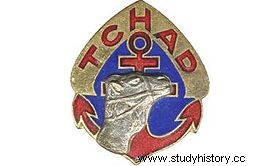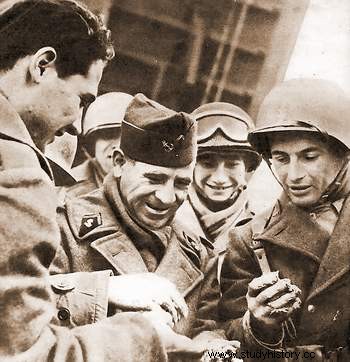
The Chad Marching Regiment is a VBCI infantry regiment of the French Army. He belongs to the navy troops. Since July 1, 2010, it has been based in Meyenheim, south of Colmar (Haut-Rhin), on the former air base 132.
History
It was created in Morocco in July 1943 from the metropolitan personnel of the Regiment of Senegalese Tirailleurs from Chad and metropolitan and European elements rallied in North Africa under the command of Colonel Dio. It becomes the mechanized infantry regiment of the 2nd Armored Division, commanded by General Leclerc. By decision of January 17, 1944, the Chad marching regiment was proclaimed "heir to the traditions of the Senegalese tirailleurs regiment of Chad in the continuation of the war action carried out by the colonial troops. The Croix de Guerre with two palms and the fourragère in the colors of the Croix de Guerre are thus conferred on the flag of the Chad marching regiment”.
It is called the "oath regiment" following the promise made in Koufra on March 2, 1941 by Colonel Leclerc "Swear not to lay down your arms until our colors, our beautiful colors, float on the cathedral of Strasbourg. Indeed, the regiment took part, among other things, in the liberation of Paris and then that of Strasbourg.
In September 1943, the division was transferred to Rabat in Morocco, where it was equipped with weapons from the United States:160 M4 Sherman battle tanks, 280 M3 and M-8 Greyhound half-track armored vehicles, Dodge trucks, GMC, Brockway, Diamond and many jeeps.
The regiment was then transferred to Great Britain on various ships, including the Franconia, a requisitioned liner. While waiting for landing, he is stationed and continues his training around Hull.

Many Spaniards, veterans of the Spanish Civil War, enlisted in this regiment. They were in the majority in the 3rd battalion (known as "the Spanish battalion") and commanded by Joseph Putz, a former brigadist. The 9th Company, commanded by Captain Raymond Dronne was mainly made up of Spanish Republicans, hence its nickname "La Nueve" (the number nine in Spanish). His best-known feat of arms is to be the first to enter Paris, accompanied by a platoon of tanks from the 501st RCC, in August 1944, during the episode now called the Liberation of Paris.

In 1997, the regiment was installed in Noyon, in Picardy.
In 2005, the RMT took part in the "PAMIR XII" operation in Afghanistan within the NATO forces. In 2006, he was engaged in Lebanon within the United Nations interim force in Lebanon UNIFIL. In May 2008, the regiment was sent simultaneously to Afghanistan (operation "PAMIR XIX") and to Lebanon (operation "DAMAN VI").
In 2010, the regiment was installed in Meyenheim, Alsace.
The regiment today
Subordinations
The regiment is subordinate to the 2nd B.B., itself a component of the land action force.
Composition
The regiment has 1,000 soldiers and civilians in its ranks. It is made up of a command and logistics company (CCL), a lighting and support company (CEA), four combat companies and then a reservist company (9th company).
The first combat company:the "cobras" of Chad;
The second combat company:the "demons" of Chad;
The third combat company:the "scorpions" of Chad;
the fourth combat company:the "dragons" of Chad;
Flag
His flag takes up, something unusual in the French Army, three names of battles in which his father regiment, the Regiment of Senegalese Tirailleurs du Tchad, took part:
Koufra- 1941;
Fezzan - 1942;
South-Tunisian - 1943.
And to see it participated in person:
Alençon, 1944;
Paris, 1944;
Strasbourg, 1944.
Decorations
Companion of the Liberation since June 12, 1945
Croix de guerre 1939-1945, awarded with 4 palms (including the 2 palms to the order of the Free French Forces attributed to the Regiment of Senegalese Tirailleurs of Chad (RTST) for the victories acquired from 1941 to 1943 in Libya and Tunisia)
Military Valor Cross with palm
Fourragère in the colors of the Medal ribbon soldier with olive in the colors of the ribbon of the Croix de guerre 1939-1945
Fourragère in the colors of the ribbon of the cross of the order of the liberation since June 18, 1996. See the list of companions of the Liberation.
Insignia
"Moorish door pediment Or with the inscription in capitals Gules "TCHAD", surmounting an anchor of the same on a field of azure, with the stem in the shape of a cross of Lorraine, charged with a contoured head of a camel of 'money'
Outdoor screenings
1941 Chad, Libya:
1942 Libya;
1944 England;
1944-45 France, Germany;
1945-47 Indochina;
1955-59 Morocco;
1985 Djibouti;
1986 Germany-Berlin;
1986 Ivory Coast;
1987 New Caledonia;
1987 Ivory Coast;
1990 Kuwait;
1995 Bosnia and Herzegovina;
1995 Martinique;
1997 Bosnia and Herzegovina;
1998 Bosnia and Herzegovina;
1999 Kosovo;
1999 Martinique;
2000 Kosovo;
2001 Chad;
2001 Martinique;
2002 Ivory Coast;
2002 Macedonia;
2003 Central African Republic;
2004 Kosovo;
2005 Senegal;
2005 Afghanistan;
2005 Guyana;
2005 Ivory Coast;
2006 Lebanon;
2007 Kosovo;
2007 Ivory Coast;
2007 Senegal;
2008 Afghanistan;
2008 Lebanon;
2009 Kosovo;
2009 Guyana;
2009 Chad;
2010 Afghanistan;
2011 Ivory Coast;
2011 Chad;
2011 Afghanistan;
2011 Central African Republic;
2012 Lebanon;
2012 UAE;
2013 Qatar
2013 UAE;
2014 Chad/CAR
2014 Mali
2014 New Caledonia
2014 Tahiti
Leaders
1940/42:Colonel Philippe Leclerc de Hautecloque;
1942/43:Colonel François Ingold;
1943/46:Colonel Louis Dio;
1946:Commander André Lavergne;
1946/48:Lieutenant-Colonel Jean Fournier;
1948:Lieutenant-Colonel Jean Morvan;
1948:Commander Jean Beillard;
1949/5:1 Commander Marcel Dupin;
1951/52:Lieutenant-Colonel Roger Fournier;
1952/54:Lieutenant-Colonel Raymond Thiers;
1954:Commander Jacques Foubert;
1954/58:Lieutenant-Colonel Jean Bley;
1958/59:Lieutenant-Colonel Gustave Bouyer;
1959/61:Commander Francis Bourriquen;
1961/64:Lieutenant -colonel Jean-Marie Héliot;
1964:Lieutenant-colonel P aul Lartigues;
1964/66:Colonel Jean Bellec, companion of the Liberation;
1966/68:Colonel Roger Ravel;
1968/70:Colonel Michel de Boisset;
1970/72:Colonel Michel du Payrat;
1972/74:Colonel Paul Cavarrot;
1974/76:Colonel Jean Muller;
1976/78:Colonel Jean-François Gin;
1978/80:Colonel Jacques Bouvet;
1980/82:Colonel Jean Elie;
1984/86:Colonel Gérard Roques;
1986/88:Colonel Christian Vaganay;
1988/90:Colonel Alain Cartron;
1990/92:Colonel Jean-Louis Wintrebert;
1992/94:Colonel Jean -Paul Richard;
1994/96:Colonel Jean-Paul Michel;
1996/98:Colonel Eric de Stabenrath;
1998/2000:Colonel Philippe Bonnel;
2000/2002:Colonel Michel Rochelet;
2002/2004:Colonel Bertrand de Reboul;
2004/2006:Colonel Henry Ducret;
2006/2008:Colonel Olivier de Cevins;
2008/2010:Colonel Henry de Medlege;
2010/2012:Colonel Philippe François;
2012/2014:Colonel Aymeric Tardieu de Maleissye Melun;
2014 /:Colonel Francois Beaucournu
Traditions
Party of the Marines
It is celebrated on the occasion of the anniversary of the battles of Bazeilles. This village which was taken over and abandoned four times on orders, on August 31 and September 1, 1870.
And in the Name of God, long live the colonial
Porpoises and bigors have God himself as their patron saint. This battle cry ends the internal ceremonies of the life of the regiments. Its origin is a thanksgiving of the Reverend Father Charles de Foucauld, missionary, seeing the colonial units come to his aid one day when he was in difficulty with a local tribe.
In a specific way
the Régiment de Marche du Tchad celebrates the victory of Koufra, the first victory of Free France on March 2, 1941, the day of the collective oath taken around General Leclerc, and the founding act of the unit in its current name .
